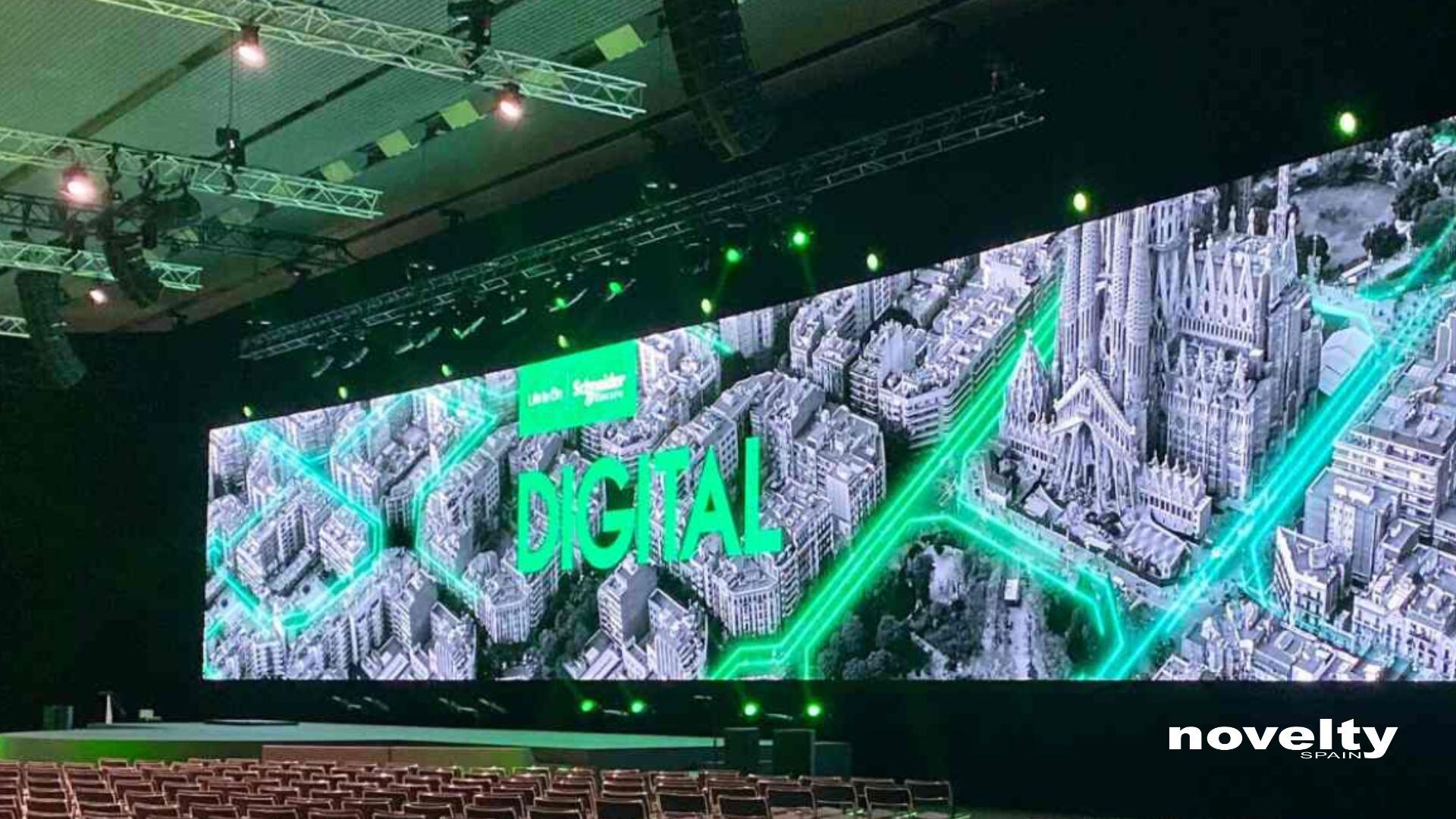Dushow Spain is now Novelty Spain
Projection Screen vs. LED Screen: Making the best choice for your event
Without a doubt, individuals attending events are demanding more quality than ever in every detail. When it comes to audiovisual content media, making the right choice is fundamental.
A projection screen and LED screen are currently the two most popular options, but what are the pros and cons of each one? What should you consider when making your decision? Read on to find out.
Projection screen
For years now, a projection screen has been the main medium for multimedia projections at any type of event. In truth, it is still a great option because, after the notable improvements made to this AV AV technology, the quality it offers has augmented significantly.
There is now a wide range of projection screens that are extremely versatile. A few of the options are:
- Tripod screens: commonly used at small events, as their built-in stand makes them easy to set up. They are affordable and easy to transport.
- Roll-up screens: another good alternative for small-format events are roll-up screens. Despite their larger size, they are quite easy to install.
- Personalized projection screen: ideal for large and medium-size events. Usually larger in size, they offer great image quality. You’ll need to consider the image-to-screen ratio, as well as ambient lighting and any glare. They offer an impactful visual beacon for the audience. If they need to be hung, they may require rigging.
- Additionally, a large projection screen is particularly effective in creating a captivating visual experience at sizable gatherings. A large projection screen provide an immersive display that enhances the overall impact of visuals, making them ideal for events with a considerable audience.
Choosing the right projection screen is essential to getting good results. Beyond using the right projector, that offers good resolution and is compatible with a number of formats, attention must be paid to the aspect ratio, the available space and the distance between the projector and projection screen. It is also important to know whether it will be a front or rear projection.
Pros of using a projection screen
We will now discuss some of their main advantages. Projection screen:
- Come in a wide range of sizes.
- Are easier to transport and install.
- Are versatile.
- Are more economic than LED screens.
- Offer a good-quality image.
Cons of using a projection screen
However, when making your decision, you should also remember their weaknesses.
- A projection screen can’t be used at outdoor events or in the daylight. The ambient light competes directly with that of the projector, thus reducing the contrast of the projected image. Any colored light that lands on the screen can also tint the projected image.
- It can be difficult to get the right distance between the projector and screen.
- If it is a front-projection, unwelcome shadows can be cast if speakers stand in front of the projector.
If you’d like to learn more about the possibilities that a projection screen offer, watch the following video showing actual examples:
LED Screens
In contrast to the projection screen, in recent years LED screens have become a popular choice at all types of events. LED screens offer excellent image quality thanks to the thousands of light pixels that make them up. Their use has become common at small and large-scale events, both indoor and out.
LED Screens, OLED or LED walls are some of the most popular alternatives. They all make an ideal medium to communicate a message to all attendees, as they are able to reproduce any type of content. As for the format, large-sized screens can be installed.
Pros of LED Screens
The use of LED screens, and much of their current popularity, is thanks to the major advantages that this type of audiovisual medium can bring. Chiefly, they offer:
- high-definition image quality.
- major connectivity.
- broad variety of shapes and sizes.
- affordable options.
- resistance to adverse conditions.
Cons of LED Screens
Their drawbacks mainly have to do with the budgeting and technical work that goes into them:
- Large-sized screens may require a big budget.
- They imply greater technical work.
- At short distances, they are low-definition.
Projection screen vs. LED screen: how to make the best decision
Both projection and LED screens are technically viable in many different situations. Conducting a preliminary study of your needs, and conditions of the event will be a fundamental step. In the following paragraphs, you’ll find a number of key points we recommend you consider when it comes to making your decision.
Size of the venue and number of attendees
Before choosing a projection screen, bear in mind the size of the venue where your event is to be held. You need plenty of obstruction-free room between the projection and projector. Otherwise, the experience can turn out to be negative.
It is also recommendable to consider the number of attendees at your event. The bigger the event, the more space you will need to install your screen, as it will have to cover a broader range of vision.
Ambient light (indoor LED/outdoor LED)
If you’re going to hold an event outdoors, or with a high level of light, you can’t choose a projection screen, since they offer sub-par results in such conditions. You’ll have to choose an outdoor LED, as they do have enough power to work correctly in brightly lit scenarios.
That said, you’ll need to choose a LED screen with the right IP degree, nits and resolution (pixel pitch). If the audience is somewhat distant from the screen, as tends to be the case at outdoor events, you can choose lower-resolution screens. Indoors, it’s recommended to use LED modules with greater pixel density.
Quality/resolution
An LED screen regularly offers superior resolution and image quality compared to that of a projection screen. Nevertheless, an LED projector can also achieve high-quality images and resolutions of up to 4K, although the resulting image may appear somewhat more blurred. In any case, it is crucial to work towards safeguarding image quality and ensuring, at the very least, Full HD
Screen size/Aspect ratio
Of course, you must give careful consideration to the size of your screen. At small events, it may be that a 50-inch LED screen or a tripod projection screen are more than sufficient. There should be a directly proportionate relationship between the size and the volume of the audience if you want to offer a good audiovisual experience.
The Aspect Ratio of your screen also plays a key role. The 16:9 ratio seems to have become the industry standard, ahead of 4:3. Either can be valid, depending on your needs. But you should make sure that the aspect ratio chosen is aligned with the content to be broadcast/projected.
Number of screens
At important events held in large venues, it’s normal for the audience to be distributed throughout the space. In such situations, you can combine LED and projection screens, although a minimum standard of quality should be kept up among all of the screens. At smaller events, it’s best to aim for quality over quantity, as long as it’s possible.
Budget
Obviously, you must always consider your budget. While small LED screens or projection screens are more affordable, a large projection screen or LED wall can be quite costly. Striking a balance between expense and functionality is essential, for organizers, who want the greatest possible profitability, and the attendees, who expect an unforgettable experience.
Key items to remember
Looking after each of the details at your event is the only way to provide a satisfactory experience to your attendees and, as shown, choosing between the projection screen or LED screens is not a trivial decision. Nevertheless, if you consider all of the recommendations made in this article, we’re certain you’ll make the right decision.
As you’ve probably gathered by now, knowing the differences between a projection screen and a LED screen can become a key factor, with an influence on the results of your next event.
Contact our expert project managers now and get all your questions answered for the audiovisual technical production of your next event.
This article was first published in Novelty Spain, you can read the original Spanish version here.





